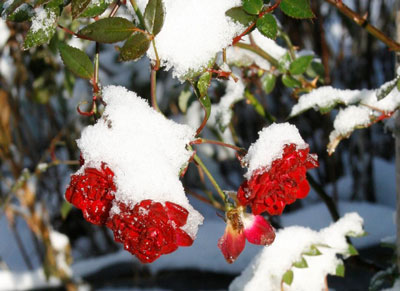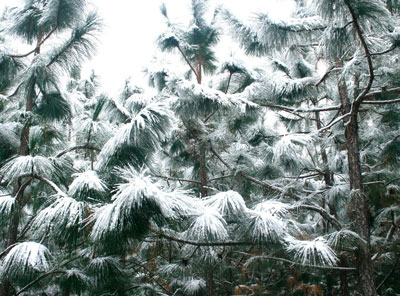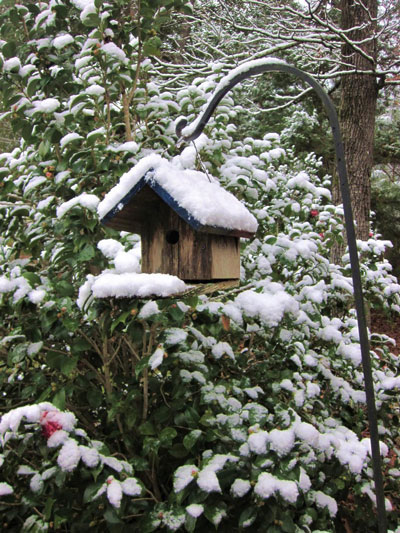Let it snow, let it snow

Snow accentuates layers in landscapes. Here, a perennial border containing crape myrtle, rose, cassia, butterfly vine, and other plants creates the first level in a large landscape. Behind the perennial border, longleaf pine trees form a transition into natural woodlands.
Practically speaking, snow is a natural insulator and a source of moisture. But even the lightest, most fleeting of snow blankets, like the recent fluffy filigree that garnished Southeast Texas, gives a new perspective to gardens. Snow simplifies, it accentuates, it calms, and it glorifies.

Snow intensifies color, including blooms from a late season rose.
Snow begins its garden transformation by hiding distractions. Gone are the dead patches, discolored foliage, and dingy stepping stones; in their places, an angelic, calming monotone that quells commotion and accentuates open space.
Where snow is present, shape and form leap to the forefront. Ornamental grasses, hedge shrubs, and camellias’ dense, leathery foliage each carries its snow cloak in a distinctive manner. During snowfall, agave’s thick leaf rosettes become collection bins. Sometimes, so much snow builds up on the long, spiny blades the tops appear white, creating sharp contrast to the green undersides.

Longleaf pines add a dramatic flair when highlighted with snow.
Snow exaggerates pattern and texture, as well. Pine needles thicken, taking on a heavy, yet graceful, demeanor. At ground level, snow highlights circles and rows of daffodils and other bulbs. In kitchen gardens, rows of onion tops form a green grid against the frothy white ground. Even the intricate curlicues found in trellises and gates become more pronounced when dusted with snow.

A dusting of snow signals winter’s arrival at “home tweet home.”
Snow spotlights birds, berries, and bark, too. When set against winter’s alabaster backdrop, the ruby glint of a cardinal’s wing is more vibrant than ever. Red holly berries beckon, catching the eye like gemstones. Tree bark, especially dark, craggy bark, becomes more pronounced.
Snow sits on benches like cushions; it collects in birdbaths like sea foam. Snow crowns statues. In fact, few garden elements escape the beautifying effects of snow.

Cat lovers (more than cats) appreciate snow’s ability to define and accentuate.
Snow is ephemeral: It vanishes as quickly and quietly as it came. In no time, the white blanket soaks into the ground as the snow crowns and cushions melt, rendering the garden—with all of its shortcomings—as it was before. What snow leaves behind, however, is a renewed sense of wonder.
